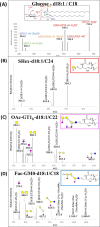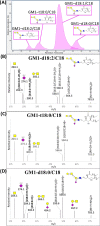Profiling Intact Glycosphingolipids with Automated Structural Annotation and Quantitation from Human Samples with Nanoflow Liquid Chromatography Mass Spectrometry
- PMID: 38563595
- PMCID: PMC11024888
- DOI: 10.1021/acs.analchem.4c00077
Profiling Intact Glycosphingolipids with Automated Structural Annotation and Quantitation from Human Samples with Nanoflow Liquid Chromatography Mass Spectrometry
Abstract
Sphingolipids are an essential subset of bioactive lipids found in most eukaryotic cells that contribute to membrane biophysical properties and are involved in cellular differentiation, recognition, and mediating interactions. The described nanoHPLC-ESI-Q/ToF methodology utilizes known biosynthetic pathways, accurate mass detection, optimized collision-induced disassociation, and a robust nanoflow chromatographic separation for the analysis of intact sphingolipids found in human tissue, cells, and serum. The methodology was developed and validated with an emphasis on addressing the common issues experienced in profiling these amphipathic lipids, which are part of the glycocalyx and lipidome. The high sensitivity obtained using nanorange flow rates with robust chromatographic reproducibility over a wide range of concentrations and injection volumes results in confident identifications for profiling these low-abundant biomolecules.
Conflict of interest statement
The authors declare no competing financial interest.
Figures






Similar articles
-
[Fast determination of per- and polyfluoroalkyl substances in human serum by cold-induced phase separation coupled with liquid chromatography-tandem mass spectrometry].Se Pu. 2025 Jul;43(7):756-766. doi: 10.3724/SP.J.1123.2024.11028. Se Pu. 2025. PMID: 40610770 Free PMC article. Chinese.
-
Can a Liquid Biopsy Detect Circulating Tumor DNA With Low-passage Whole-genome Sequencing in Patients With a Sarcoma? A Pilot Evaluation.Clin Orthop Relat Res. 2025 Jan 1;483(1):39-48. doi: 10.1097/CORR.0000000000003161. Epub 2024 Jun 21. Clin Orthop Relat Res. 2025. PMID: 38905450
-
[Preparation and chromatographic performance evaluation of hydrophilic interaction chromatography stationary phase based on amino acids].Se Pu. 2025 Jul;43(7):734-743. doi: 10.3724/SP.J.1123.2025.04015. Se Pu. 2025. PMID: 40610768 Free PMC article. Chinese.
-
Antidepressants for pain management in adults with chronic pain: a network meta-analysis.Health Technol Assess. 2024 Oct;28(62):1-155. doi: 10.3310/MKRT2948. Health Technol Assess. 2024. PMID: 39367772 Free PMC article.
-
Automated devices for identifying peripheral arterial disease in people with leg ulceration: an evidence synthesis and cost-effectiveness analysis.Health Technol Assess. 2024 Aug;28(37):1-158. doi: 10.3310/TWCG3912. Health Technol Assess. 2024. PMID: 39186036 Free PMC article.
Cited by
-
Don't Be Surprised When These Surprise You: Some Infrequently Studied Sphingoid Bases, Metabolites, and Factors That Should Be Kept in Mind During Sphingolipidomic Studies.Int J Mol Sci. 2025 Jan 14;26(2):650. doi: 10.3390/ijms26020650. Int J Mol Sci. 2025. PMID: 39859363 Free PMC article. Review.
-
DANGO: An MS data annotation tool for glycolipidomics.BBA Adv. 2025 Apr 27;7:100161. doi: 10.1016/j.bbadva.2025.100161. eCollection 2025. BBA Adv. 2025. PMID: 40485743 Free PMC article.
-
An Optimized Liquid Chromatography-Mass Spectrometry Method for Ganglioside Analysis in Cell Lines.Cells. 2024 Oct 2;13(19):1640. doi: 10.3390/cells13191640. Cells. 2024. PMID: 39404403 Free PMC article.
-
Region-specific quantitation of glycosphingolipids in the elderly human brain with Nanoflow MEA Chip Q/ToF mass spectrometry.Glycobiology. 2025 Apr 23;35(6):cwaf022. doi: 10.1093/glycob/cwaf022. Glycobiology. 2025. PMID: 40207879 Free PMC article.
References
-
- Schnaar R. L.; Sandhoff R.; Tiemeyer M.; Kinoshita T.. Glycosphingolipids. In Essentials of Glycobiology, 4th ed.; Varki A.et al., Ed.; Cold Spring Harbor Laboratory Press: Cold Spring Harbor, NY, 2022; Chapter 11. https://www.ncbi.nlm.nih.gov/books/NBK579905/.
-
- Thudichum J. A Treatise on the Chemical Constitution of the Brain; Based Throughout upon Original Researches. Glasgow Med. J. 1884, 22 (5), 363–364.

